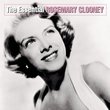| All Artists: Rosemary Clooney, Duke Ellington Title: Blue Rose Members Wishing: 2 Total Copies: 0 Label: Tristar Release Date: 8/19/1994 Genres: Jazz, Pop, Broadway & Vocalists Styles: Traditional Jazz & Ragtime, Vocal Jazz, Oldies, Vocal Pop, Classic Vocalists, Musicals, Traditional Vocal Pop Number of Discs: 1 SwapaCD Credits: 1 UPC: 766923661222 |
Search - Rosemary Clooney, Duke Ellington :: Blue Rose
 | Rosemary Clooney, Duke Ellington Blue Rose Genres: Jazz, Pop, Broadway & Vocalists
While the names Rosemary Clooney and Duke Ellington appear on the cover, the person most responsible for these unusual 1956 recordings was Ellington's regular collaborator, arranger Billy Strayhorn. When the project develo... more » |
CD DetailsSynopsis
Amazon.com While the names Rosemary Clooney and Duke Ellington appear on the cover, the person most responsible for these unusual 1956 recordings was Ellington's regular collaborator, arranger Billy Strayhorn. When the project developed, Clooney was in the midst of a difficult pregnancy and unable to leave Los Angeles. Strayhorn visited her to work on the arrangements, eventually moving in and becoming nurse as well as orchestrator, picking the material with Clooney and arranging familiar Ellington classics and some of his own songs, like "I'm Checking Out (Goombye)," to suit her voice. The situation eventually required that the band and vocal tracks be recorded separately, the first time the technique had been attempted by major artists, and it's remarkable testimony to Strayhorn's writing and supervision that the natural-sounding results were achieved. Clooney's rich timbre, clear diction, and fine rhythmic sense are well suited to the material, and the Ellington band, as always, was both a fine orchestral instrument and a collection of great soloists. There's also an evocatively exotic instrumental performance of Strayhorn's signature "Passion Flower," with Johnny Hodges's trademark alto saxophone standing out. The recording is an unusual chapter in the Ellington band's history, a showcase for Strayhorn's arrangements and an early chance for Clooney to demonstrate just how good a jazz singer lurked behind her lightweight hits of the day. --Stuart Broomer Similar CDs
|
CD ReviewsDuke and Rosey Bomojaz | South Central PA, USA | 03/26/2006 (5 out of 5 stars) " If the apex of Ellington's career would occur before a wild crowd at the 1956 Newport Jazz Festival, this album with Rosemary Clooney, recorded six months earlier, would sigfnify an important step toward that feat. For one thing, it marked on record the return to the band of alto saxophonist Johnny Hodges, who had been absent since his departure in 1950. There is a beauty to Hodges's playing, especially on PASSION FLOWER, a specialty of his, that seems to be declaring a joy in being back: he plays with Caruso-like emotion on this title. Clooney's vocals are rock steady; I LET A SONG GO OUT OF MY HEART and I GOT IT BAD are particularly nice. Her best vocal, however, is on ME AND YOU, a tune Ivey Anderson first sang back in 1940. Other highlights include Jimmy Hamilton's clarinet work on I'M CHECKIN' OUT-GOOMBYE, Harry Carney's baritone sax solo on HEY BABY, and Paul Gonsalves's swinging tenor on IT DON'T MEAN A THING. Duke's carreer was not a lock at this time, but this album helped solidify the band that would make it so in just a few months." "Pretend You're A Girl Getting Ready For a Date" Stephanie DePue | Carolina Beach, NC USA | 04/22/2009 (4 out of 5 stars) "Rosemary Clooney's "Blue Rose," on which she performs a repertory largely written by Duke Ellington and his uber-talented arranger/co-composer, Billy Strayhorn, with Ellington and his orchestra, was initially released in 1956 by Sony Music. It has been remastered and rereleased by Columbia Legacy, with two bonus tracks, "If You Were in My Place," and "Just A-Sittin' and a Rockin'."The initial album was arranged by Strayhorn, and produced by Irving Townsend. Apparently it was produced in what was considered an odd way, then as now, with Ellington and his Orchestra, and Clooney, laying down their tracks separately. The liner notes apparently offer some explanation for this, but they are reproduced in such tiny print that I can't read them. As arranged by Strayhorn, there is no trace of the commercialized, Columbia, Clooney foghorn voice we heard on such of her hits as "Come on a My House" that was arranged by that label's talented, but very commercially oriented Mitch Miller. Strayhorn supposedly told Clooney, "Don't think of yourself as someone singing with an orchestra. Just pretend you're a girl getting ready for a date, an important date with someone you love, and you're really looking forward to it. And as you're brushing your hair, you hear Duke Ellington on the radio. Almost subconsciously, you start humming along with the band, not thinking at all about what you're singing." The heavily-pregnant Clooney must have gotten what Strayhorn was saying, as the music is sophisticated, intimate, mellow, cool, with a late night sound. Sound quality was unusually good on the initial release, and remains high in the remastered release. "It Don't Mean a Thing," "Grieving, Hey Baby," and "Me and You," are generally considered among the singer's highlights on the album. Other highlights include two beautiful instrumentals, "Passion Flower," and the title song that Ellington wrote for Clooney: both feature Johnny Hodges, who had just returned to the orchestra. However, to my ear, some of the cuts do have a dated, 1950's style; and some of Strayhorn's arrangements seem to echo those of his famous contemporary Nelson Riddle, who was making his name with Frank Sinatra, but had also worked with Clooney earlier in her career. In fact, I'm a girl who's been lucky enough to see Clooney twice in person, in her later years. Once at New York's World Financial Center, downtown: (it used to abut the World Trade Center, but it's still standing, alone, today), and once at Carnegie Hall (bless those acoustics). I'd have to say that, even considering the inevitable loss of voice that the singer had suffered since 1956, I preferred her later work: I found it warmer and gutsier. Of course, I'm no great jazz maven. Many of them do seem to consider this earlier album a great one. Guess it's a matter of individual taste. " Blue rose review K. lord | minnesota | 06/26/2009 (4 out of 5 stars) "i have enjoyed listening to this cd. rosemary clooney is one of the best female vocalists. i love listening to her singing jazz & of course w/ one of the greats, duke ellington. how can you go wrong with this combo??? it is a great listen!!"
|

 Track Listings (13) - Disc #1
Track Listings (13) - Disc #1

